Gig Economy and Labour: An Analysis of TreeBox Solutions, Singapore
VerifiedAdded on 2020/03/07
|15
|3836
|40
Report
AI Summary
This research report investigates the gig economy's influence on the labour market, focusing on the Singaporean context and using TreeBox Solutions as a case study. The report begins with an executive summary and table of contents, followed by an introduction outlining the changing nature of work and the rise of the gig economy. A comprehensive literature review defines work nature, explores sustainability, and analyzes the strengths and weaknesses of the gig economy, including its impact on workers' lives. The methodology includes structured interviews with eight respondents from TreeBox Solutions. Data analysis of the interview responses and findings are presented, highlighting both the advantages and disadvantages of the gig economy, such as flexibility versus inconsistent income and job security concerns. The report concludes by summarizing the key insights and implications of the gig economy for workers and the labour market in Singapore, emphasizing the importance of understanding and adapting to these evolving work dynamics. References and interview questions are included in the appendices.
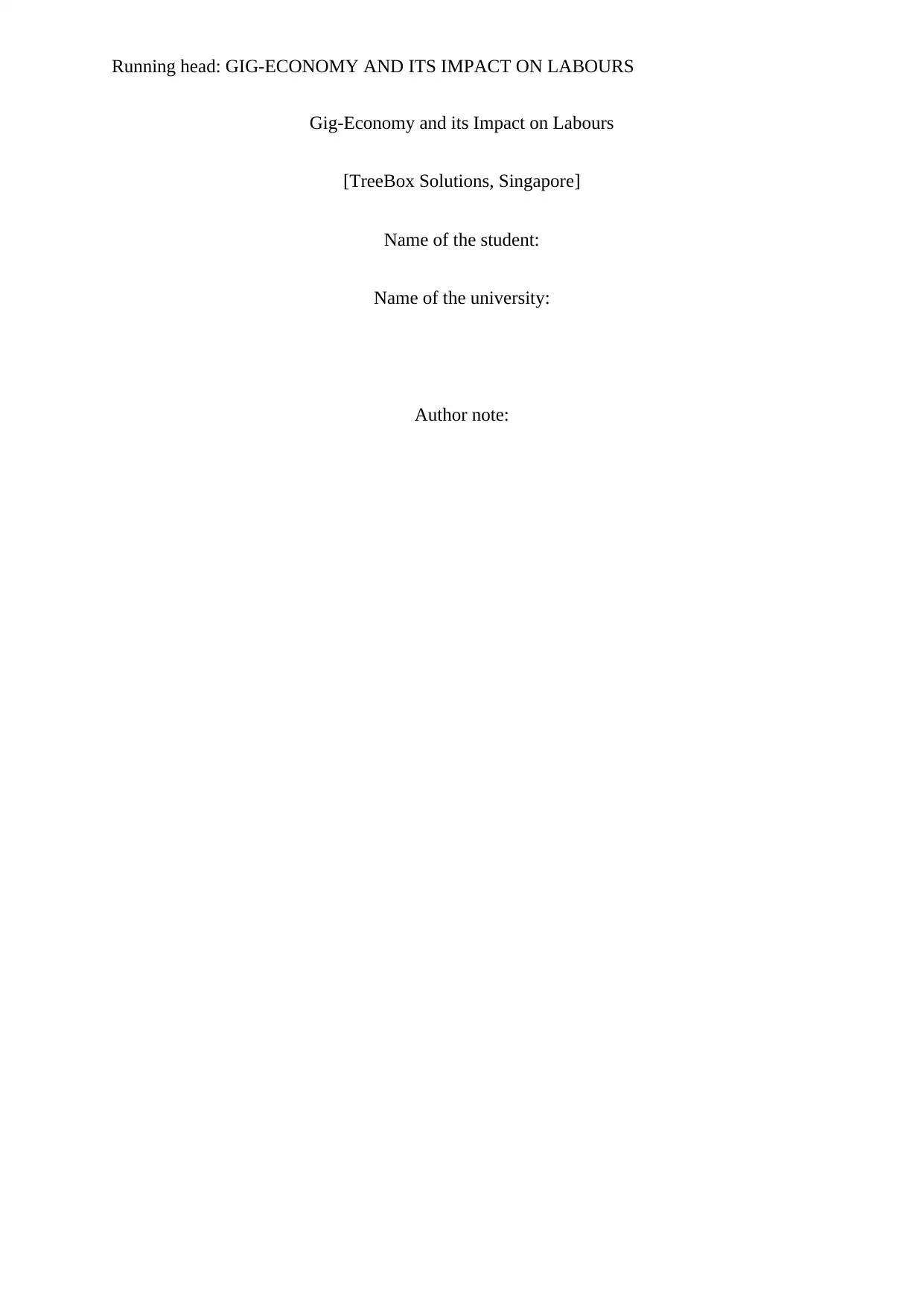
Running head: GIG-ECONOMY AND ITS IMPACT ON LABOURS
Gig-Economy and its Impact on Labours
[TreeBox Solutions, Singapore]
Name of the student:
Name of the university:
Author note:
Gig-Economy and its Impact on Labours
[TreeBox Solutions, Singapore]
Name of the student:
Name of the university:
Author note:
Paraphrase This Document
Need a fresh take? Get an instant paraphrase of this document with our AI Paraphraser
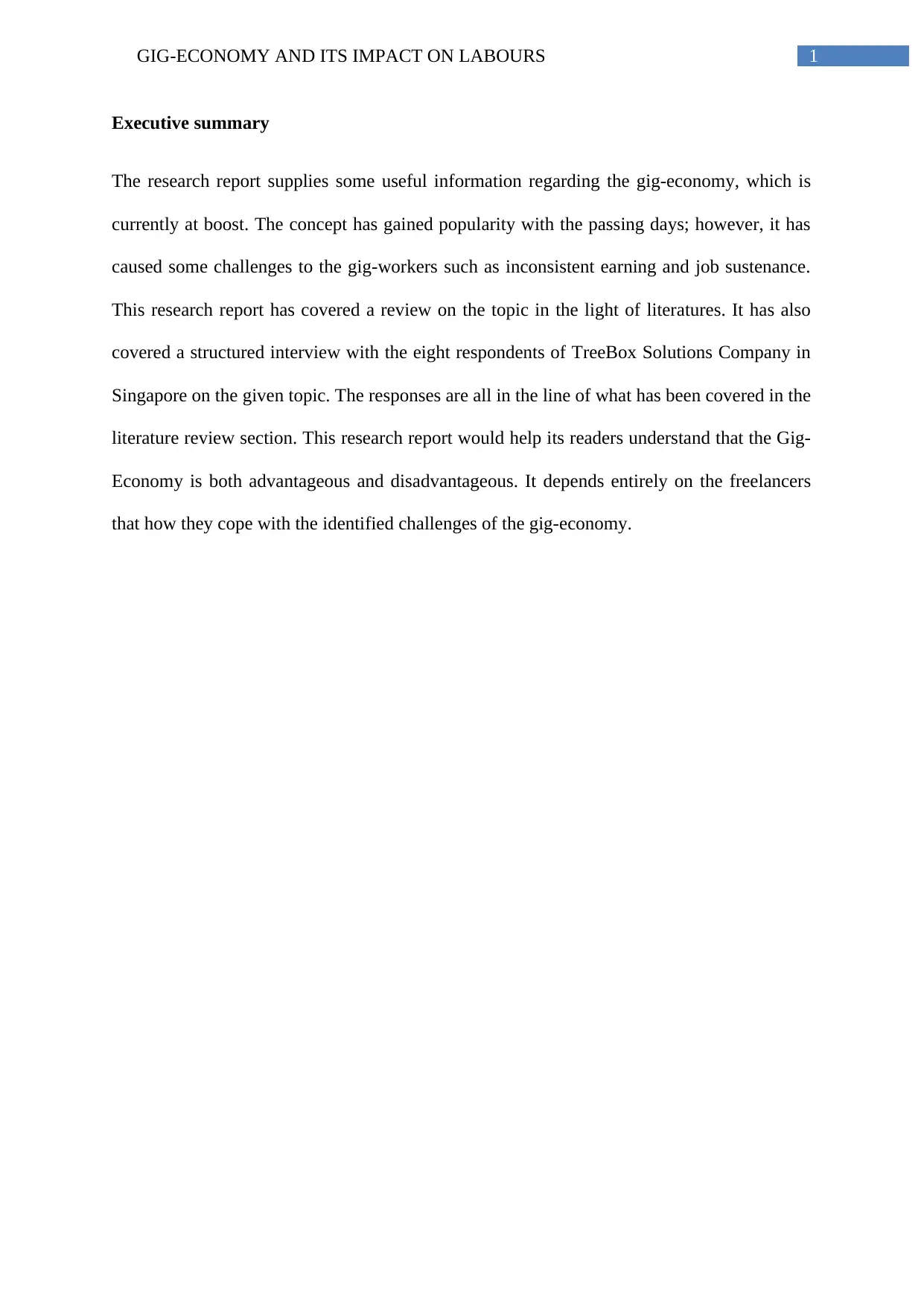
1GIG-ECONOMY AND ITS IMPACT ON LABOURS
Executive summary
The research report supplies some useful information regarding the gig-economy, which is
currently at boost. The concept has gained popularity with the passing days; however, it has
caused some challenges to the gig-workers such as inconsistent earning and job sustenance.
This research report has covered a review on the topic in the light of literatures. It has also
covered a structured interview with the eight respondents of TreeBox Solutions Company in
Singapore on the given topic. The responses are all in the line of what has been covered in the
literature review section. This research report would help its readers understand that the Gig-
Economy is both advantageous and disadvantageous. It depends entirely on the freelancers
that how they cope with the identified challenges of the gig-economy.
Executive summary
The research report supplies some useful information regarding the gig-economy, which is
currently at boost. The concept has gained popularity with the passing days; however, it has
caused some challenges to the gig-workers such as inconsistent earning and job sustenance.
This research report has covered a review on the topic in the light of literatures. It has also
covered a structured interview with the eight respondents of TreeBox Solutions Company in
Singapore on the given topic. The responses are all in the line of what has been covered in the
literature review section. This research report would help its readers understand that the Gig-
Economy is both advantageous and disadvantageous. It depends entirely on the freelancers
that how they cope with the identified challenges of the gig-economy.
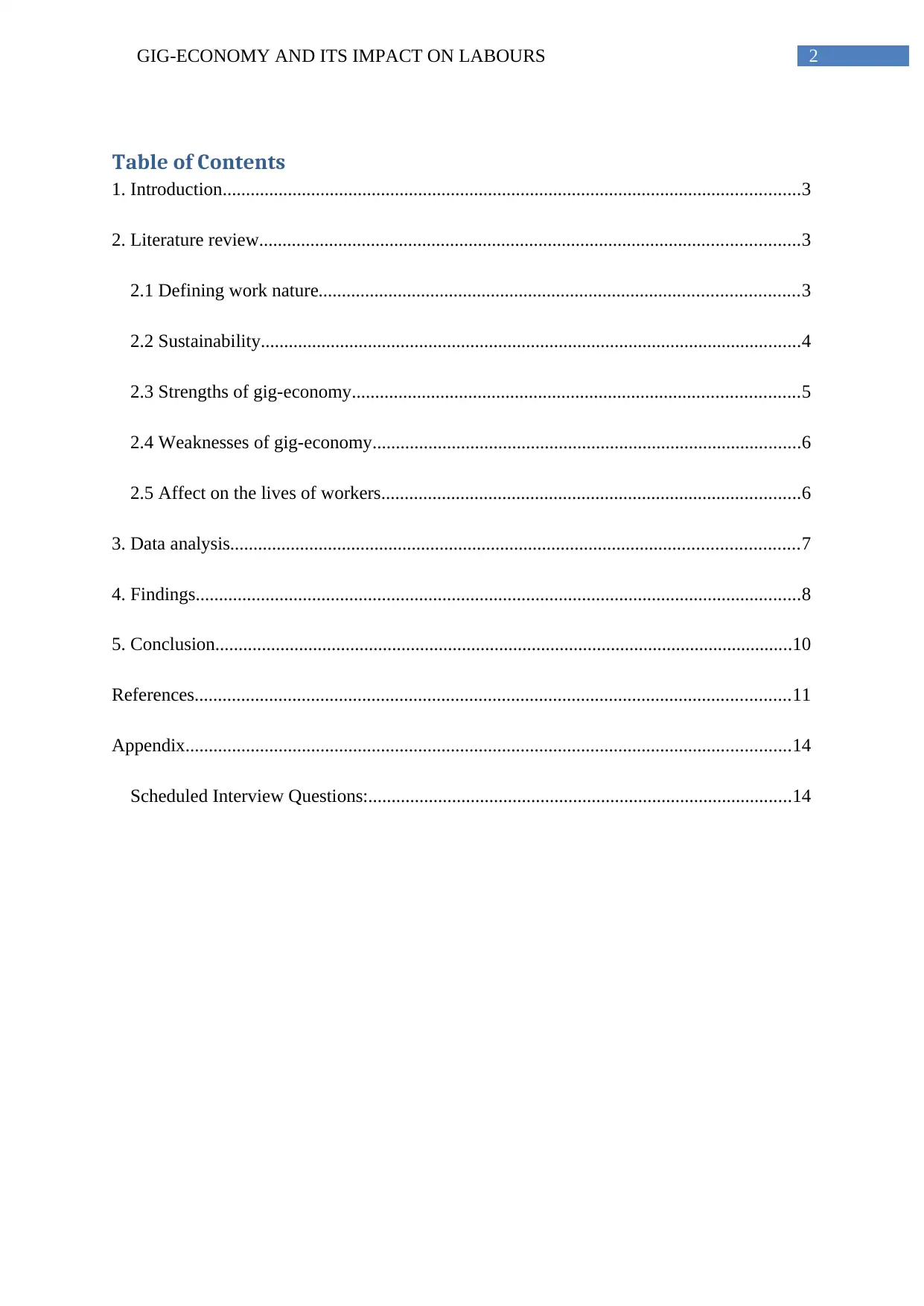
2GIG-ECONOMY AND ITS IMPACT ON LABOURS
Table of Contents
1. Introduction............................................................................................................................3
2. Literature review....................................................................................................................3
2.1 Defining work nature.......................................................................................................3
2.2 Sustainability....................................................................................................................4
2.3 Strengths of gig-economy................................................................................................5
2.4 Weaknesses of gig-economy............................................................................................6
2.5 Affect on the lives of workers..........................................................................................6
3. Data analysis..........................................................................................................................7
4. Findings..................................................................................................................................8
5. Conclusion............................................................................................................................10
References................................................................................................................................11
Appendix..................................................................................................................................14
Scheduled Interview Questions:...........................................................................................14
Table of Contents
1. Introduction............................................................................................................................3
2. Literature review....................................................................................................................3
2.1 Defining work nature.......................................................................................................3
2.2 Sustainability....................................................................................................................4
2.3 Strengths of gig-economy................................................................................................5
2.4 Weaknesses of gig-economy............................................................................................6
2.5 Affect on the lives of workers..........................................................................................6
3. Data analysis..........................................................................................................................7
4. Findings..................................................................................................................................8
5. Conclusion............................................................................................................................10
References................................................................................................................................11
Appendix..................................................................................................................................14
Scheduled Interview Questions:...........................................................................................14
⊘ This is a preview!⊘
Do you want full access?
Subscribe today to unlock all pages.

Trusted by 1+ million students worldwide
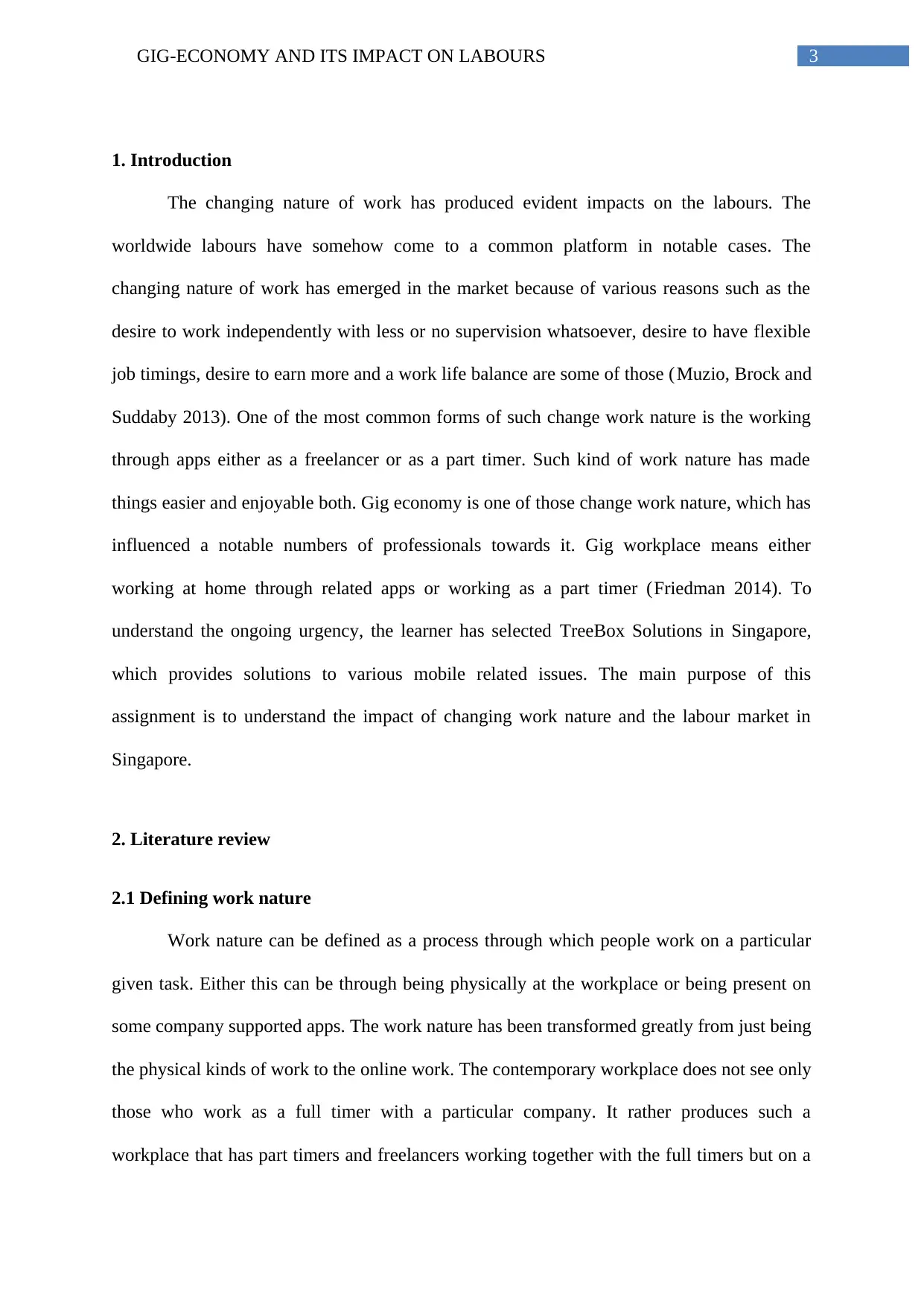
3GIG-ECONOMY AND ITS IMPACT ON LABOURS
1. Introduction
The changing nature of work has produced evident impacts on the labours. The
worldwide labours have somehow come to a common platform in notable cases. The
changing nature of work has emerged in the market because of various reasons such as the
desire to work independently with less or no supervision whatsoever, desire to have flexible
job timings, desire to earn more and a work life balance are some of those (Muzio, Brock and
Suddaby 2013). One of the most common forms of such change work nature is the working
through apps either as a freelancer or as a part timer. Such kind of work nature has made
things easier and enjoyable both. Gig economy is one of those change work nature, which has
influenced a notable numbers of professionals towards it. Gig workplace means either
working at home through related apps or working as a part timer (Friedman 2014). To
understand the ongoing urgency, the learner has selected TreeBox Solutions in Singapore,
which provides solutions to various mobile related issues. The main purpose of this
assignment is to understand the impact of changing work nature and the labour market in
Singapore.
2. Literature review
2.1 Defining work nature
Work nature can be defined as a process through which people work on a particular
given task. Either this can be through being physically at the workplace or being present on
some company supported apps. The work nature has been transformed greatly from just being
the physical kinds of work to the online work. The contemporary workplace does not see only
those who work as a full timer with a particular company. It rather produces such a
workplace that has part timers and freelancers working together with the full timers but on a
1. Introduction
The changing nature of work has produced evident impacts on the labours. The
worldwide labours have somehow come to a common platform in notable cases. The
changing nature of work has emerged in the market because of various reasons such as the
desire to work independently with less or no supervision whatsoever, desire to have flexible
job timings, desire to earn more and a work life balance are some of those (Muzio, Brock and
Suddaby 2013). One of the most common forms of such change work nature is the working
through apps either as a freelancer or as a part timer. Such kind of work nature has made
things easier and enjoyable both. Gig economy is one of those change work nature, which has
influenced a notable numbers of professionals towards it. Gig workplace means either
working at home through related apps or working as a part timer (Friedman 2014). To
understand the ongoing urgency, the learner has selected TreeBox Solutions in Singapore,
which provides solutions to various mobile related issues. The main purpose of this
assignment is to understand the impact of changing work nature and the labour market in
Singapore.
2. Literature review
2.1 Defining work nature
Work nature can be defined as a process through which people work on a particular
given task. Either this can be through being physically at the workplace or being present on
some company supported apps. The work nature has been transformed greatly from just being
the physical kinds of work to the online work. The contemporary workplace does not see only
those who work as a full timer with a particular company. It rather produces such a
workplace that has part timers and freelancers working together with the full timers but on a
Paraphrase This Document
Need a fresh take? Get an instant paraphrase of this document with our AI Paraphraser
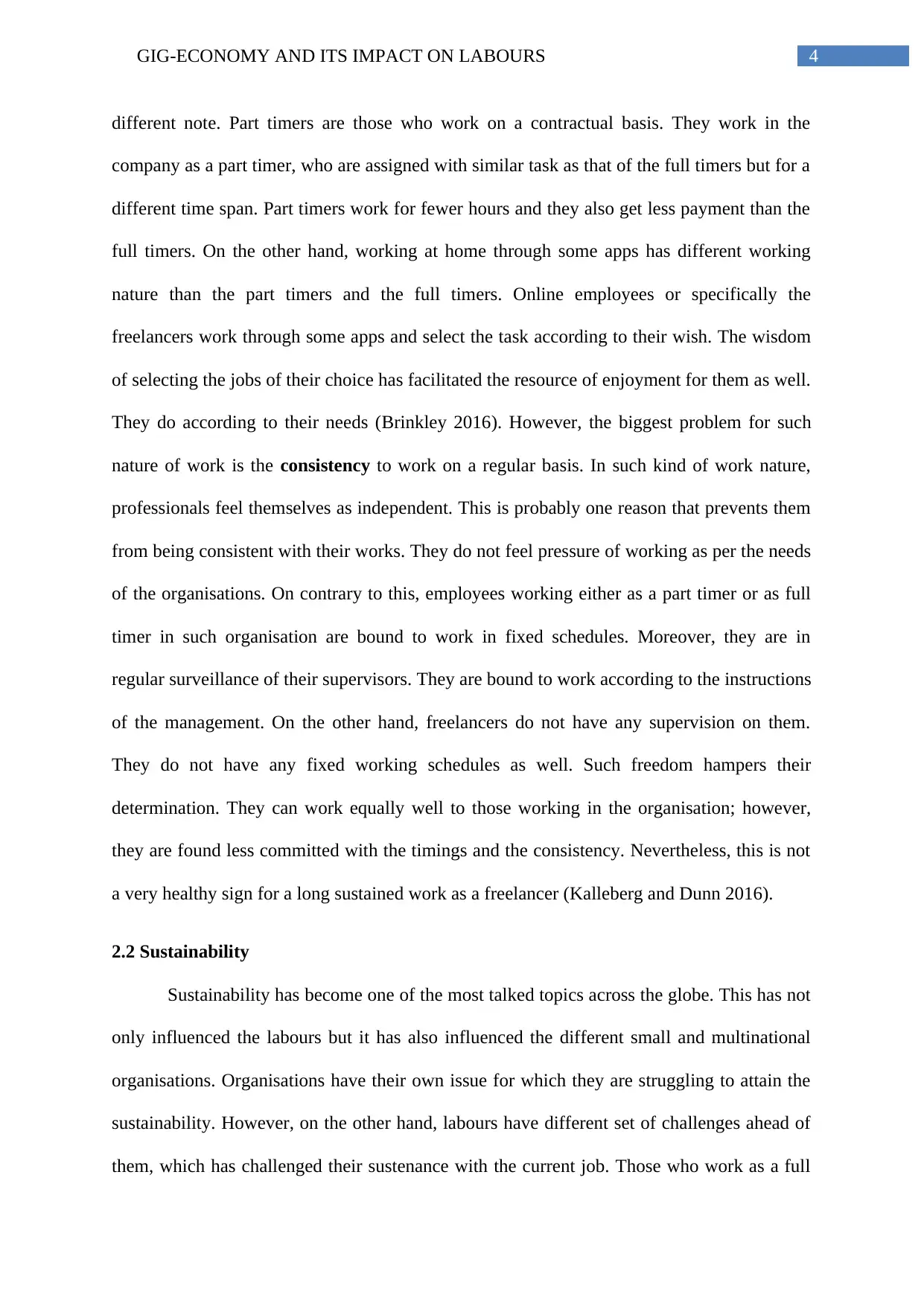
4GIG-ECONOMY AND ITS IMPACT ON LABOURS
different note. Part timers are those who work on a contractual basis. They work in the
company as a part timer, who are assigned with similar task as that of the full timers but for a
different time span. Part timers work for fewer hours and they also get less payment than the
full timers. On the other hand, working at home through some apps has different working
nature than the part timers and the full timers. Online employees or specifically the
freelancers work through some apps and select the task according to their wish. The wisdom
of selecting the jobs of their choice has facilitated the resource of enjoyment for them as well.
They do according to their needs (Brinkley 2016). However, the biggest problem for such
nature of work is the consistency to work on a regular basis. In such kind of work nature,
professionals feel themselves as independent. This is probably one reason that prevents them
from being consistent with their works. They do not feel pressure of working as per the needs
of the organisations. On contrary to this, employees working either as a part timer or as full
timer in such organisation are bound to work in fixed schedules. Moreover, they are in
regular surveillance of their supervisors. They are bound to work according to the instructions
of the management. On the other hand, freelancers do not have any supervision on them.
They do not have any fixed working schedules as well. Such freedom hampers their
determination. They can work equally well to those working in the organisation; however,
they are found less committed with the timings and the consistency. Nevertheless, this is not
a very healthy sign for a long sustained work as a freelancer (Kalleberg and Dunn 2016).
2.2 Sustainability
Sustainability has become one of the most talked topics across the globe. This has not
only influenced the labours but it has also influenced the different small and multinational
organisations. Organisations have their own issue for which they are struggling to attain the
sustainability. However, on the other hand, labours have different set of challenges ahead of
them, which has challenged their sustenance with the current job. Those who work as a full
different note. Part timers are those who work on a contractual basis. They work in the
company as a part timer, who are assigned with similar task as that of the full timers but for a
different time span. Part timers work for fewer hours and they also get less payment than the
full timers. On the other hand, working at home through some apps has different working
nature than the part timers and the full timers. Online employees or specifically the
freelancers work through some apps and select the task according to their wish. The wisdom
of selecting the jobs of their choice has facilitated the resource of enjoyment for them as well.
They do according to their needs (Brinkley 2016). However, the biggest problem for such
nature of work is the consistency to work on a regular basis. In such kind of work nature,
professionals feel themselves as independent. This is probably one reason that prevents them
from being consistent with their works. They do not feel pressure of working as per the needs
of the organisations. On contrary to this, employees working either as a part timer or as full
timer in such organisation are bound to work in fixed schedules. Moreover, they are in
regular surveillance of their supervisors. They are bound to work according to the instructions
of the management. On the other hand, freelancers do not have any supervision on them.
They do not have any fixed working schedules as well. Such freedom hampers their
determination. They can work equally well to those working in the organisation; however,
they are found less committed with the timings and the consistency. Nevertheless, this is not
a very healthy sign for a long sustained work as a freelancer (Kalleberg and Dunn 2016).
2.2 Sustainability
Sustainability has become one of the most talked topics across the globe. This has not
only influenced the labours but it has also influenced the different small and multinational
organisations. Organisations have their own issue for which they are struggling to attain the
sustainability. However, on the other hand, labours have different set of challenges ahead of
them, which has challenged their sustenance with the current job. Those who work as a full
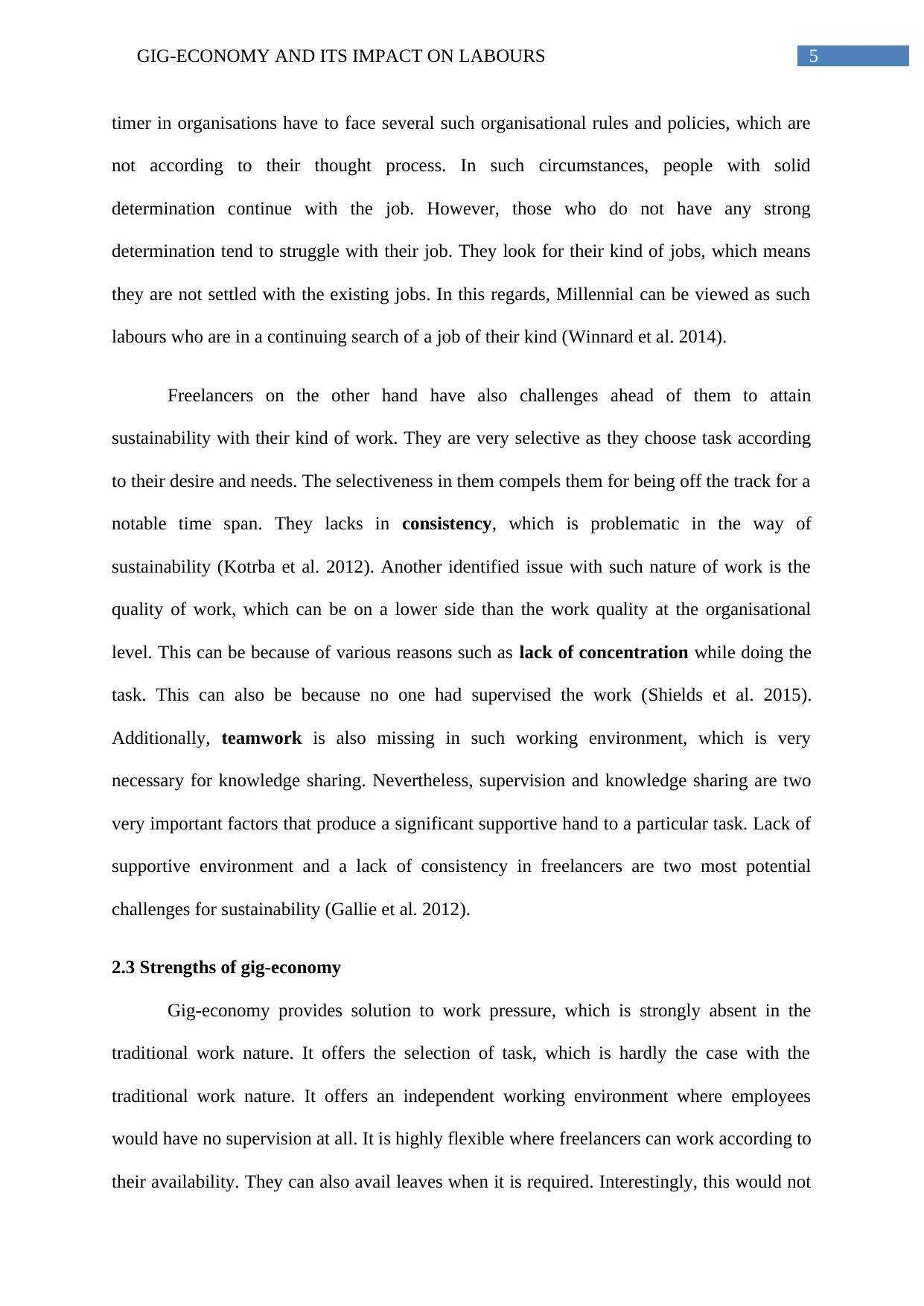
5GIG-ECONOMY AND ITS IMPACT ON LABOURS
timer in organisations have to face several such organisational rules and policies, which are
not according to their thought process. In such circumstances, people with solid
determination continue with the job. However, those who do not have any strong
determination tend to struggle with their job. They look for their kind of jobs, which means
they are not settled with the existing jobs. In this regards, Millennial can be viewed as such
labours who are in a continuing search of a job of their kind (Winnard et al. 2014).
Freelancers on the other hand have also challenges ahead of them to attain
sustainability with their kind of work. They are very selective as they choose task according
to their desire and needs. The selectiveness in them compels them for being off the track for a
notable time span. They lacks in consistency, which is problematic in the way of
sustainability (Kotrba et al. 2012). Another identified issue with such nature of work is the
quality of work, which can be on a lower side than the work quality at the organisational
level. This can be because of various reasons such as lack of concentration while doing the
task. This can also be because no one had supervised the work (Shields et al. 2015).
Additionally, teamwork is also missing in such working environment, which is very
necessary for knowledge sharing. Nevertheless, supervision and knowledge sharing are two
very important factors that produce a significant supportive hand to a particular task. Lack of
supportive environment and a lack of consistency in freelancers are two most potential
challenges for sustainability (Gallie et al. 2012).
2.3 Strengths of gig-economy
Gig-economy provides solution to work pressure, which is strongly absent in the
traditional work nature. It offers the selection of task, which is hardly the case with the
traditional work nature. It offers an independent working environment where employees
would have no supervision at all. It is highly flexible where freelancers can work according to
their availability. They can also avail leaves when it is required. Interestingly, this would not
timer in organisations have to face several such organisational rules and policies, which are
not according to their thought process. In such circumstances, people with solid
determination continue with the job. However, those who do not have any strong
determination tend to struggle with their job. They look for their kind of jobs, which means
they are not settled with the existing jobs. In this regards, Millennial can be viewed as such
labours who are in a continuing search of a job of their kind (Winnard et al. 2014).
Freelancers on the other hand have also challenges ahead of them to attain
sustainability with their kind of work. They are very selective as they choose task according
to their desire and needs. The selectiveness in them compels them for being off the track for a
notable time span. They lacks in consistency, which is problematic in the way of
sustainability (Kotrba et al. 2012). Another identified issue with such nature of work is the
quality of work, which can be on a lower side than the work quality at the organisational
level. This can be because of various reasons such as lack of concentration while doing the
task. This can also be because no one had supervised the work (Shields et al. 2015).
Additionally, teamwork is also missing in such working environment, which is very
necessary for knowledge sharing. Nevertheless, supervision and knowledge sharing are two
very important factors that produce a significant supportive hand to a particular task. Lack of
supportive environment and a lack of consistency in freelancers are two most potential
challenges for sustainability (Gallie et al. 2012).
2.3 Strengths of gig-economy
Gig-economy provides solution to work pressure, which is strongly absent in the
traditional work nature. It offers the selection of task, which is hardly the case with the
traditional work nature. It offers an independent working environment where employees
would have no supervision at all. It is highly flexible where freelancers can work according to
their availability. They can also avail leaves when it is required. Interestingly, this would not
⊘ This is a preview!⊘
Do you want full access?
Subscribe today to unlock all pages.

Trusted by 1+ million students worldwide
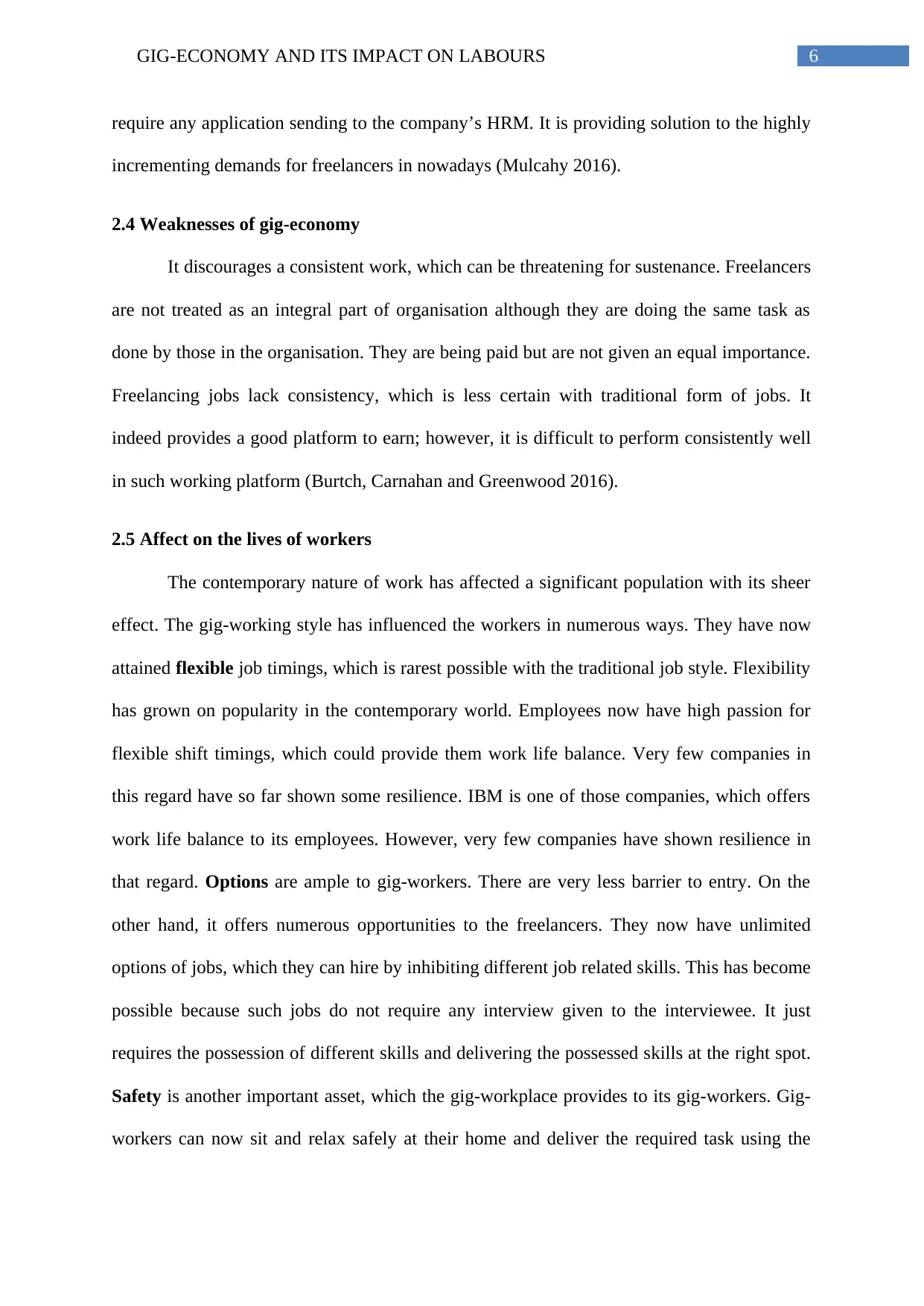
6GIG-ECONOMY AND ITS IMPACT ON LABOURS
require any application sending to the company’s HRM. It is providing solution to the highly
incrementing demands for freelancers in nowadays (Mulcahy 2016).
2.4 Weaknesses of gig-economy
It discourages a consistent work, which can be threatening for sustenance. Freelancers
are not treated as an integral part of organisation although they are doing the same task as
done by those in the organisation. They are being paid but are not given an equal importance.
Freelancing jobs lack consistency, which is less certain with traditional form of jobs. It
indeed provides a good platform to earn; however, it is difficult to perform consistently well
in such working platform (Burtch, Carnahan and Greenwood 2016).
2.5 Affect on the lives of workers
The contemporary nature of work has affected a significant population with its sheer
effect. The gig-working style has influenced the workers in numerous ways. They have now
attained flexible job timings, which is rarest possible with the traditional job style. Flexibility
has grown on popularity in the contemporary world. Employees now have high passion for
flexible shift timings, which could provide them work life balance. Very few companies in
this regard have so far shown some resilience. IBM is one of those companies, which offers
work life balance to its employees. However, very few companies have shown resilience in
that regard. Options are ample to gig-workers. There are very less barrier to entry. On the
other hand, it offers numerous opportunities to the freelancers. They now have unlimited
options of jobs, which they can hire by inhibiting different job related skills. This has become
possible because such jobs do not require any interview given to the interviewee. It just
requires the possession of different skills and delivering the possessed skills at the right spot.
Safety is another important asset, which the gig-workplace provides to its gig-workers. Gig-
workers can now sit and relax safely at their home and deliver the required task using the
require any application sending to the company’s HRM. It is providing solution to the highly
incrementing demands for freelancers in nowadays (Mulcahy 2016).
2.4 Weaknesses of gig-economy
It discourages a consistent work, which can be threatening for sustenance. Freelancers
are not treated as an integral part of organisation although they are doing the same task as
done by those in the organisation. They are being paid but are not given an equal importance.
Freelancing jobs lack consistency, which is less certain with traditional form of jobs. It
indeed provides a good platform to earn; however, it is difficult to perform consistently well
in such working platform (Burtch, Carnahan and Greenwood 2016).
2.5 Affect on the lives of workers
The contemporary nature of work has affected a significant population with its sheer
effect. The gig-working style has influenced the workers in numerous ways. They have now
attained flexible job timings, which is rarest possible with the traditional job style. Flexibility
has grown on popularity in the contemporary world. Employees now have high passion for
flexible shift timings, which could provide them work life balance. Very few companies in
this regard have so far shown some resilience. IBM is one of those companies, which offers
work life balance to its employees. However, very few companies have shown resilience in
that regard. Options are ample to gig-workers. There are very less barrier to entry. On the
other hand, it offers numerous opportunities to the freelancers. They now have unlimited
options of jobs, which they can hire by inhibiting different job related skills. This has become
possible because such jobs do not require any interview given to the interviewee. It just
requires the possession of different skills and delivering the possessed skills at the right spot.
Safety is another important asset, which the gig-workplace provides to its gig-workers. Gig-
workers can now sit and relax safely at their home and deliver the required task using the
Paraphrase This Document
Need a fresh take? Get an instant paraphrase of this document with our AI Paraphraser
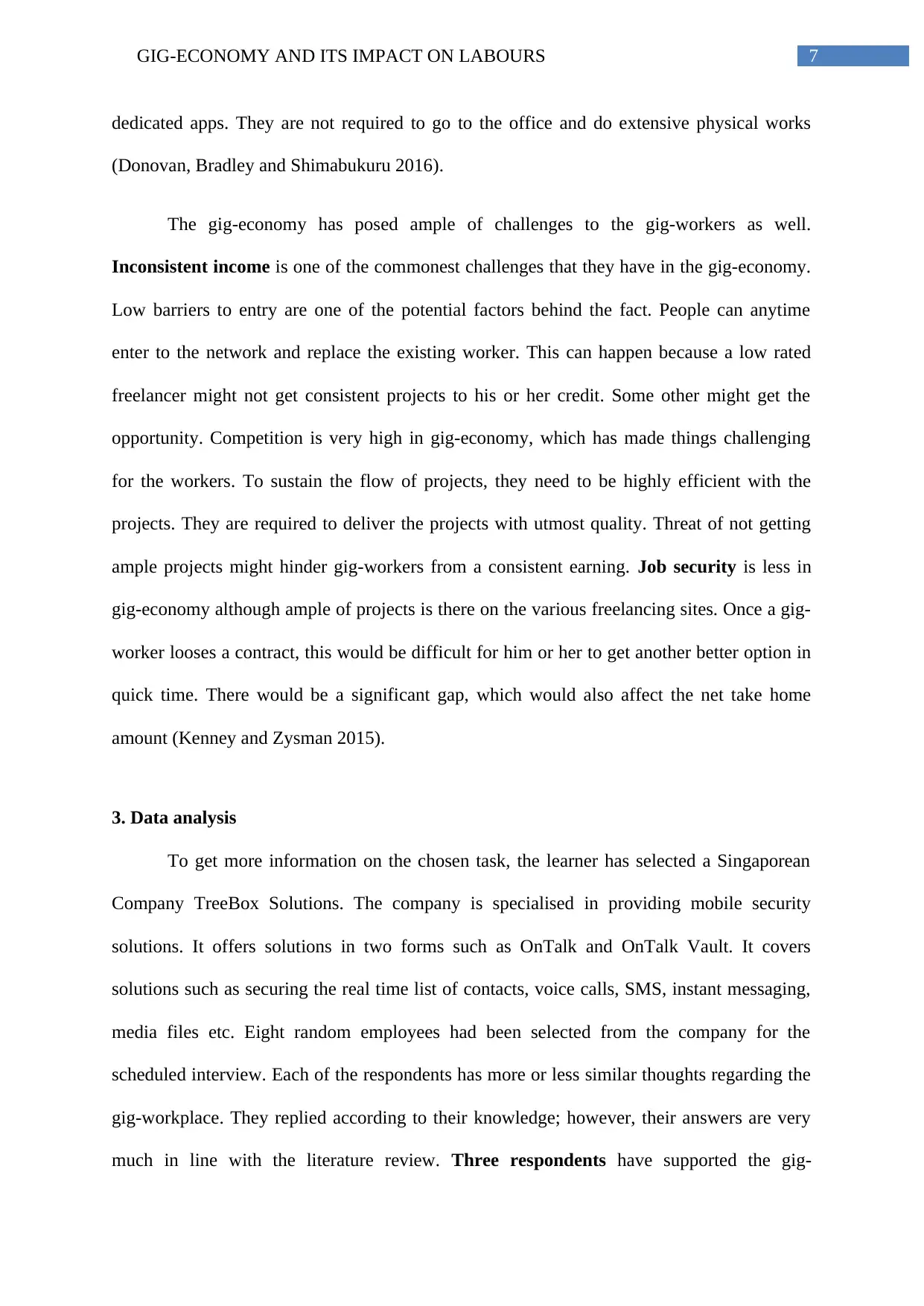
7GIG-ECONOMY AND ITS IMPACT ON LABOURS
dedicated apps. They are not required to go to the office and do extensive physical works
(Donovan, Bradley and Shimabukuru 2016).
The gig-economy has posed ample of challenges to the gig-workers as well.
Inconsistent income is one of the commonest challenges that they have in the gig-economy.
Low barriers to entry are one of the potential factors behind the fact. People can anytime
enter to the network and replace the existing worker. This can happen because a low rated
freelancer might not get consistent projects to his or her credit. Some other might get the
opportunity. Competition is very high in gig-economy, which has made things challenging
for the workers. To sustain the flow of projects, they need to be highly efficient with the
projects. They are required to deliver the projects with utmost quality. Threat of not getting
ample projects might hinder gig-workers from a consistent earning. Job security is less in
gig-economy although ample of projects is there on the various freelancing sites. Once a gig-
worker looses a contract, this would be difficult for him or her to get another better option in
quick time. There would be a significant gap, which would also affect the net take home
amount (Kenney and Zysman 2015).
3. Data analysis
To get more information on the chosen task, the learner has selected a Singaporean
Company TreeBox Solutions. The company is specialised in providing mobile security
solutions. It offers solutions in two forms such as OnTalk and OnTalk Vault. It covers
solutions such as securing the real time list of contacts, voice calls, SMS, instant messaging,
media files etc. Eight random employees had been selected from the company for the
scheduled interview. Each of the respondents has more or less similar thoughts regarding the
gig-workplace. They replied according to their knowledge; however, their answers are very
much in line with the literature review. Three respondents have supported the gig-
dedicated apps. They are not required to go to the office and do extensive physical works
(Donovan, Bradley and Shimabukuru 2016).
The gig-economy has posed ample of challenges to the gig-workers as well.
Inconsistent income is one of the commonest challenges that they have in the gig-economy.
Low barriers to entry are one of the potential factors behind the fact. People can anytime
enter to the network and replace the existing worker. This can happen because a low rated
freelancer might not get consistent projects to his or her credit. Some other might get the
opportunity. Competition is very high in gig-economy, which has made things challenging
for the workers. To sustain the flow of projects, they need to be highly efficient with the
projects. They are required to deliver the projects with utmost quality. Threat of not getting
ample projects might hinder gig-workers from a consistent earning. Job security is less in
gig-economy although ample of projects is there on the various freelancing sites. Once a gig-
worker looses a contract, this would be difficult for him or her to get another better option in
quick time. There would be a significant gap, which would also affect the net take home
amount (Kenney and Zysman 2015).
3. Data analysis
To get more information on the chosen task, the learner has selected a Singaporean
Company TreeBox Solutions. The company is specialised in providing mobile security
solutions. It offers solutions in two forms such as OnTalk and OnTalk Vault. It covers
solutions such as securing the real time list of contacts, voice calls, SMS, instant messaging,
media files etc. Eight random employees had been selected from the company for the
scheduled interview. Each of the respondents has more or less similar thoughts regarding the
gig-workplace. They replied according to their knowledge; however, their answers are very
much in line with the literature review. Three respondents have supported the gig-
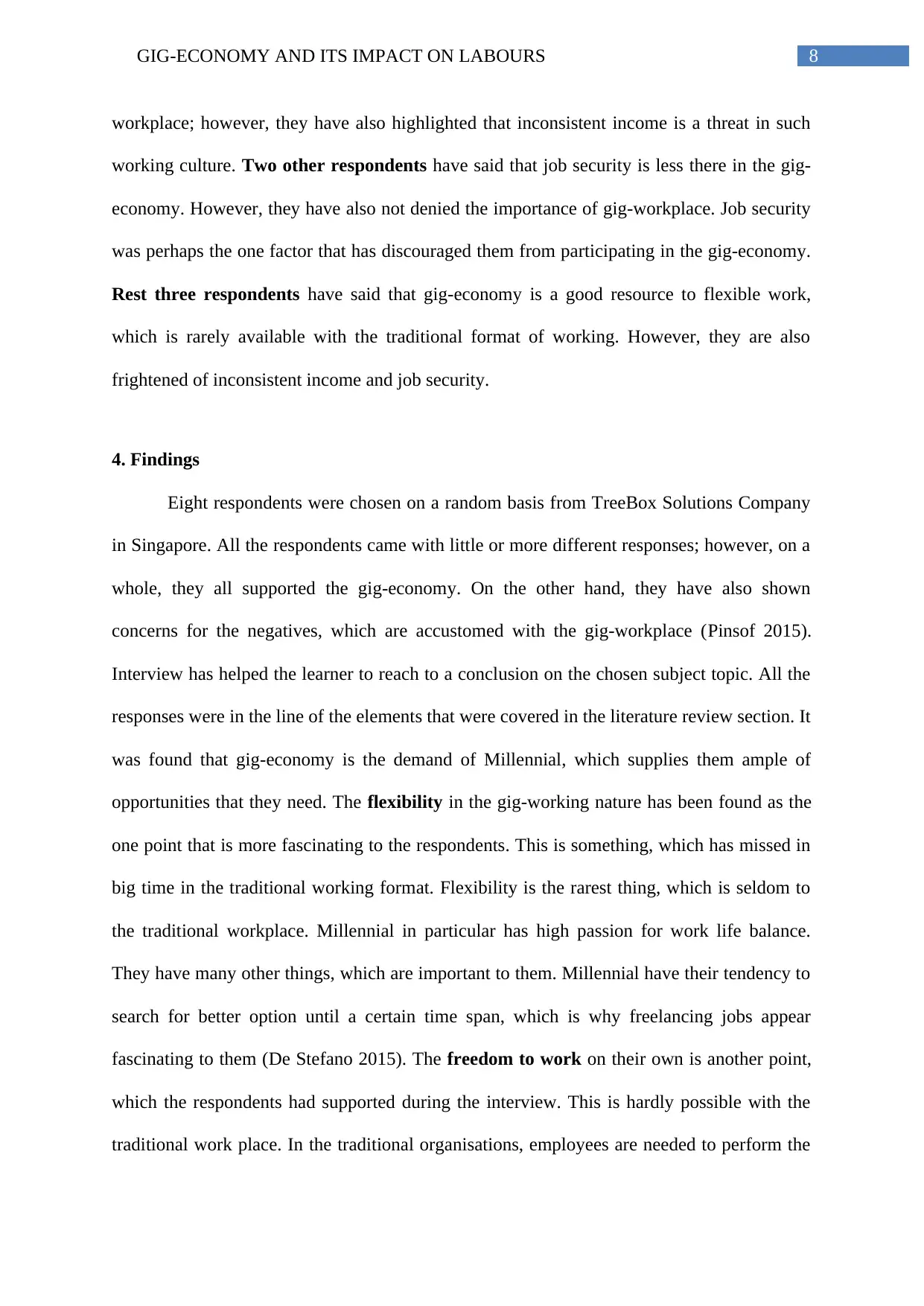
8GIG-ECONOMY AND ITS IMPACT ON LABOURS
workplace; however, they have also highlighted that inconsistent income is a threat in such
working culture. Two other respondents have said that job security is less there in the gig-
economy. However, they have also not denied the importance of gig-workplace. Job security
was perhaps the one factor that has discouraged them from participating in the gig-economy.
Rest three respondents have said that gig-economy is a good resource to flexible work,
which is rarely available with the traditional format of working. However, they are also
frightened of inconsistent income and job security.
4. Findings
Eight respondents were chosen on a random basis from TreeBox Solutions Company
in Singapore. All the respondents came with little or more different responses; however, on a
whole, they all supported the gig-economy. On the other hand, they have also shown
concerns for the negatives, which are accustomed with the gig-workplace (Pinsof 2015).
Interview has helped the learner to reach to a conclusion on the chosen subject topic. All the
responses were in the line of the elements that were covered in the literature review section. It
was found that gig-economy is the demand of Millennial, which supplies them ample of
opportunities that they need. The flexibility in the gig-working nature has been found as the
one point that is more fascinating to the respondents. This is something, which has missed in
big time in the traditional working format. Flexibility is the rarest thing, which is seldom to
the traditional workplace. Millennial in particular has high passion for work life balance.
They have many other things, which are important to them. Millennial have their tendency to
search for better option until a certain time span, which is why freelancing jobs appear
fascinating to them (De Stefano 2015). The freedom to work on their own is another point,
which the respondents had supported during the interview. This is hardly possible with the
traditional work place. In the traditional organisations, employees are needed to perform the
workplace; however, they have also highlighted that inconsistent income is a threat in such
working culture. Two other respondents have said that job security is less there in the gig-
economy. However, they have also not denied the importance of gig-workplace. Job security
was perhaps the one factor that has discouraged them from participating in the gig-economy.
Rest three respondents have said that gig-economy is a good resource to flexible work,
which is rarely available with the traditional format of working. However, they are also
frightened of inconsistent income and job security.
4. Findings
Eight respondents were chosen on a random basis from TreeBox Solutions Company
in Singapore. All the respondents came with little or more different responses; however, on a
whole, they all supported the gig-economy. On the other hand, they have also shown
concerns for the negatives, which are accustomed with the gig-workplace (Pinsof 2015).
Interview has helped the learner to reach to a conclusion on the chosen subject topic. All the
responses were in the line of the elements that were covered in the literature review section. It
was found that gig-economy is the demand of Millennial, which supplies them ample of
opportunities that they need. The flexibility in the gig-working nature has been found as the
one point that is more fascinating to the respondents. This is something, which has missed in
big time in the traditional working format. Flexibility is the rarest thing, which is seldom to
the traditional workplace. Millennial in particular has high passion for work life balance.
They have many other things, which are important to them. Millennial have their tendency to
search for better option until a certain time span, which is why freelancing jobs appear
fascinating to them (De Stefano 2015). The freedom to work on their own is another point,
which the respondents had supported during the interview. This is hardly possible with the
traditional work place. In the traditional organisations, employees are needed to perform the
⊘ This is a preview!⊘
Do you want full access?
Subscribe today to unlock all pages.

Trusted by 1+ million students worldwide
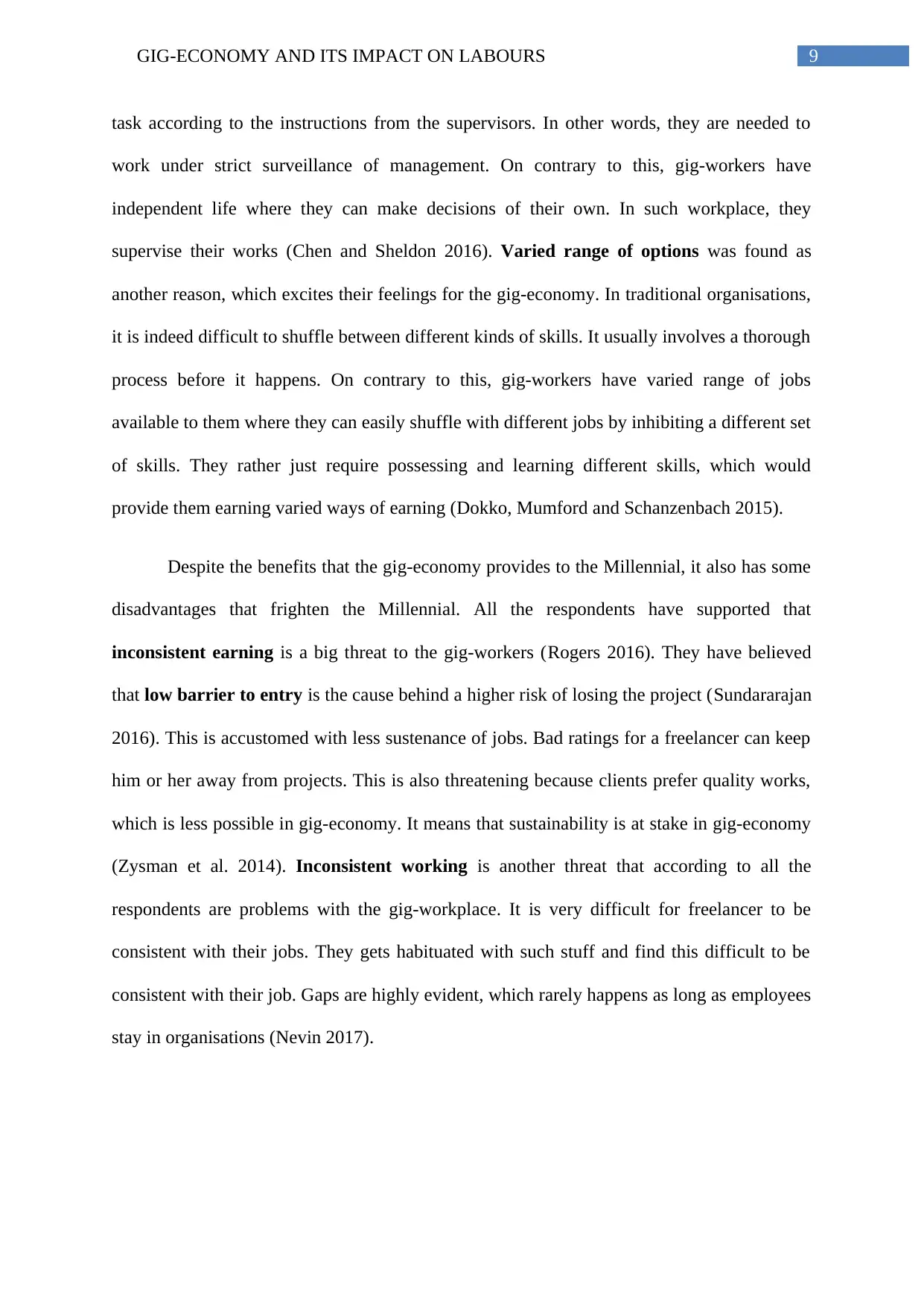
9GIG-ECONOMY AND ITS IMPACT ON LABOURS
task according to the instructions from the supervisors. In other words, they are needed to
work under strict surveillance of management. On contrary to this, gig-workers have
independent life where they can make decisions of their own. In such workplace, they
supervise their works (Chen and Sheldon 2016). Varied range of options was found as
another reason, which excites their feelings for the gig-economy. In traditional organisations,
it is indeed difficult to shuffle between different kinds of skills. It usually involves a thorough
process before it happens. On contrary to this, gig-workers have varied range of jobs
available to them where they can easily shuffle with different jobs by inhibiting a different set
of skills. They rather just require possessing and learning different skills, which would
provide them earning varied ways of earning (Dokko, Mumford and Schanzenbach 2015).
Despite the benefits that the gig-economy provides to the Millennial, it also has some
disadvantages that frighten the Millennial. All the respondents have supported that
inconsistent earning is a big threat to the gig-workers (Rogers 2016). They have believed
that low barrier to entry is the cause behind a higher risk of losing the project (Sundararajan
2016). This is accustomed with less sustenance of jobs. Bad ratings for a freelancer can keep
him or her away from projects. This is also threatening because clients prefer quality works,
which is less possible in gig-economy. It means that sustainability is at stake in gig-economy
(Zysman et al. 2014). Inconsistent working is another threat that according to all the
respondents are problems with the gig-workplace. It is very difficult for freelancer to be
consistent with their jobs. They gets habituated with such stuff and find this difficult to be
consistent with their job. Gaps are highly evident, which rarely happens as long as employees
stay in organisations (Nevin 2017).
task according to the instructions from the supervisors. In other words, they are needed to
work under strict surveillance of management. On contrary to this, gig-workers have
independent life where they can make decisions of their own. In such workplace, they
supervise their works (Chen and Sheldon 2016). Varied range of options was found as
another reason, which excites their feelings for the gig-economy. In traditional organisations,
it is indeed difficult to shuffle between different kinds of skills. It usually involves a thorough
process before it happens. On contrary to this, gig-workers have varied range of jobs
available to them where they can easily shuffle with different jobs by inhibiting a different set
of skills. They rather just require possessing and learning different skills, which would
provide them earning varied ways of earning (Dokko, Mumford and Schanzenbach 2015).
Despite the benefits that the gig-economy provides to the Millennial, it also has some
disadvantages that frighten the Millennial. All the respondents have supported that
inconsistent earning is a big threat to the gig-workers (Rogers 2016). They have believed
that low barrier to entry is the cause behind a higher risk of losing the project (Sundararajan
2016). This is accustomed with less sustenance of jobs. Bad ratings for a freelancer can keep
him or her away from projects. This is also threatening because clients prefer quality works,
which is less possible in gig-economy. It means that sustainability is at stake in gig-economy
(Zysman et al. 2014). Inconsistent working is another threat that according to all the
respondents are problems with the gig-workplace. It is very difficult for freelancer to be
consistent with their jobs. They gets habituated with such stuff and find this difficult to be
consistent with their job. Gaps are highly evident, which rarely happens as long as employees
stay in organisations (Nevin 2017).
Paraphrase This Document
Need a fresh take? Get an instant paraphrase of this document with our AI Paraphraser
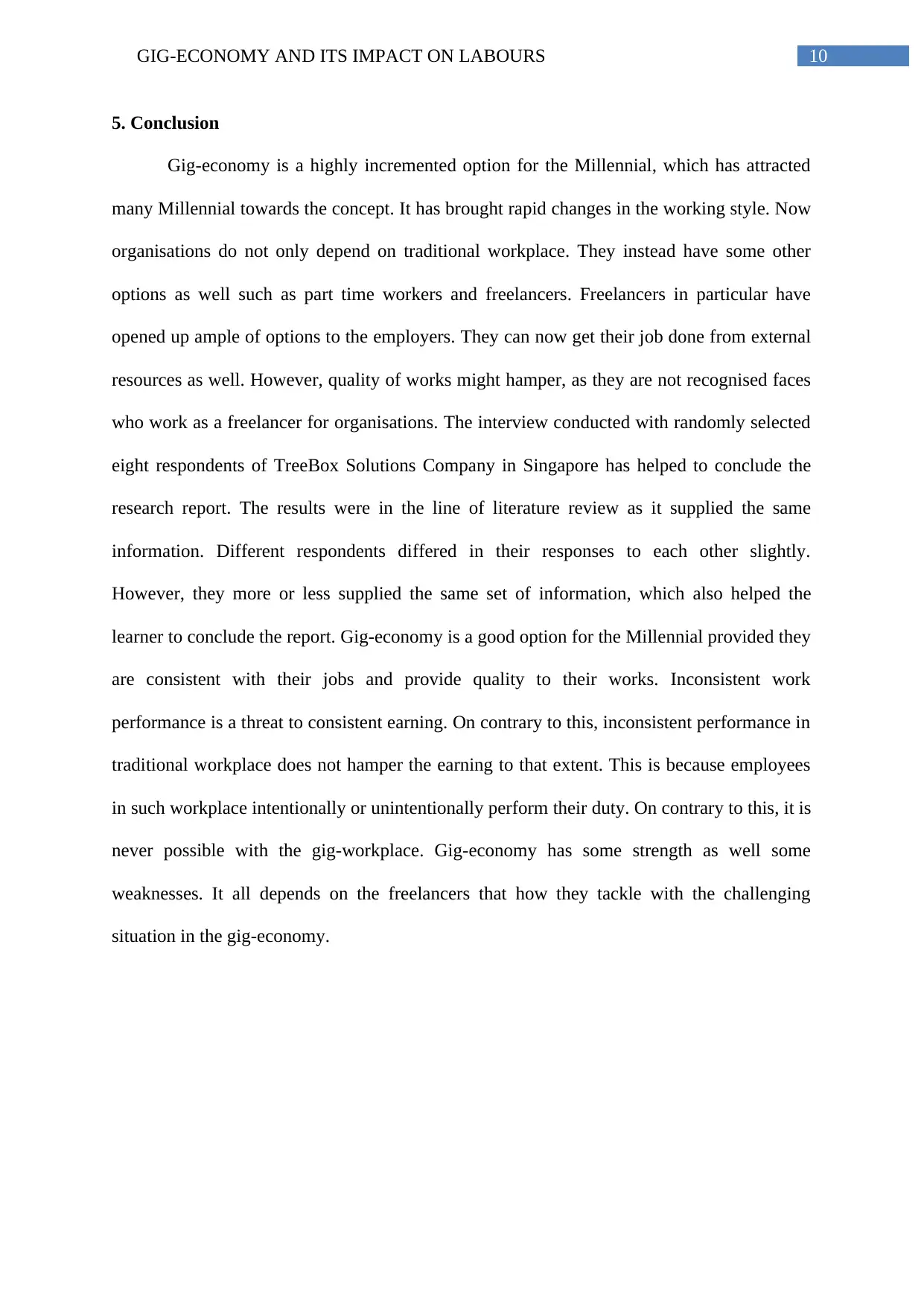
10GIG-ECONOMY AND ITS IMPACT ON LABOURS
5. Conclusion
Gig-economy is a highly incremented option for the Millennial, which has attracted
many Millennial towards the concept. It has brought rapid changes in the working style. Now
organisations do not only depend on traditional workplace. They instead have some other
options as well such as part time workers and freelancers. Freelancers in particular have
opened up ample of options to the employers. They can now get their job done from external
resources as well. However, quality of works might hamper, as they are not recognised faces
who work as a freelancer for organisations. The interview conducted with randomly selected
eight respondents of TreeBox Solutions Company in Singapore has helped to conclude the
research report. The results were in the line of literature review as it supplied the same
information. Different respondents differed in their responses to each other slightly.
However, they more or less supplied the same set of information, which also helped the
learner to conclude the report. Gig-economy is a good option for the Millennial provided they
are consistent with their jobs and provide quality to their works. Inconsistent work
performance is a threat to consistent earning. On contrary to this, inconsistent performance in
traditional workplace does not hamper the earning to that extent. This is because employees
in such workplace intentionally or unintentionally perform their duty. On contrary to this, it is
never possible with the gig-workplace. Gig-economy has some strength as well some
weaknesses. It all depends on the freelancers that how they tackle with the challenging
situation in the gig-economy.
5. Conclusion
Gig-economy is a highly incremented option for the Millennial, which has attracted
many Millennial towards the concept. It has brought rapid changes in the working style. Now
organisations do not only depend on traditional workplace. They instead have some other
options as well such as part time workers and freelancers. Freelancers in particular have
opened up ample of options to the employers. They can now get their job done from external
resources as well. However, quality of works might hamper, as they are not recognised faces
who work as a freelancer for organisations. The interview conducted with randomly selected
eight respondents of TreeBox Solutions Company in Singapore has helped to conclude the
research report. The results were in the line of literature review as it supplied the same
information. Different respondents differed in their responses to each other slightly.
However, they more or less supplied the same set of information, which also helped the
learner to conclude the report. Gig-economy is a good option for the Millennial provided they
are consistent with their jobs and provide quality to their works. Inconsistent work
performance is a threat to consistent earning. On contrary to this, inconsistent performance in
traditional workplace does not hamper the earning to that extent. This is because employees
in such workplace intentionally or unintentionally perform their duty. On contrary to this, it is
never possible with the gig-workplace. Gig-economy has some strength as well some
weaknesses. It all depends on the freelancers that how they tackle with the challenging
situation in the gig-economy.
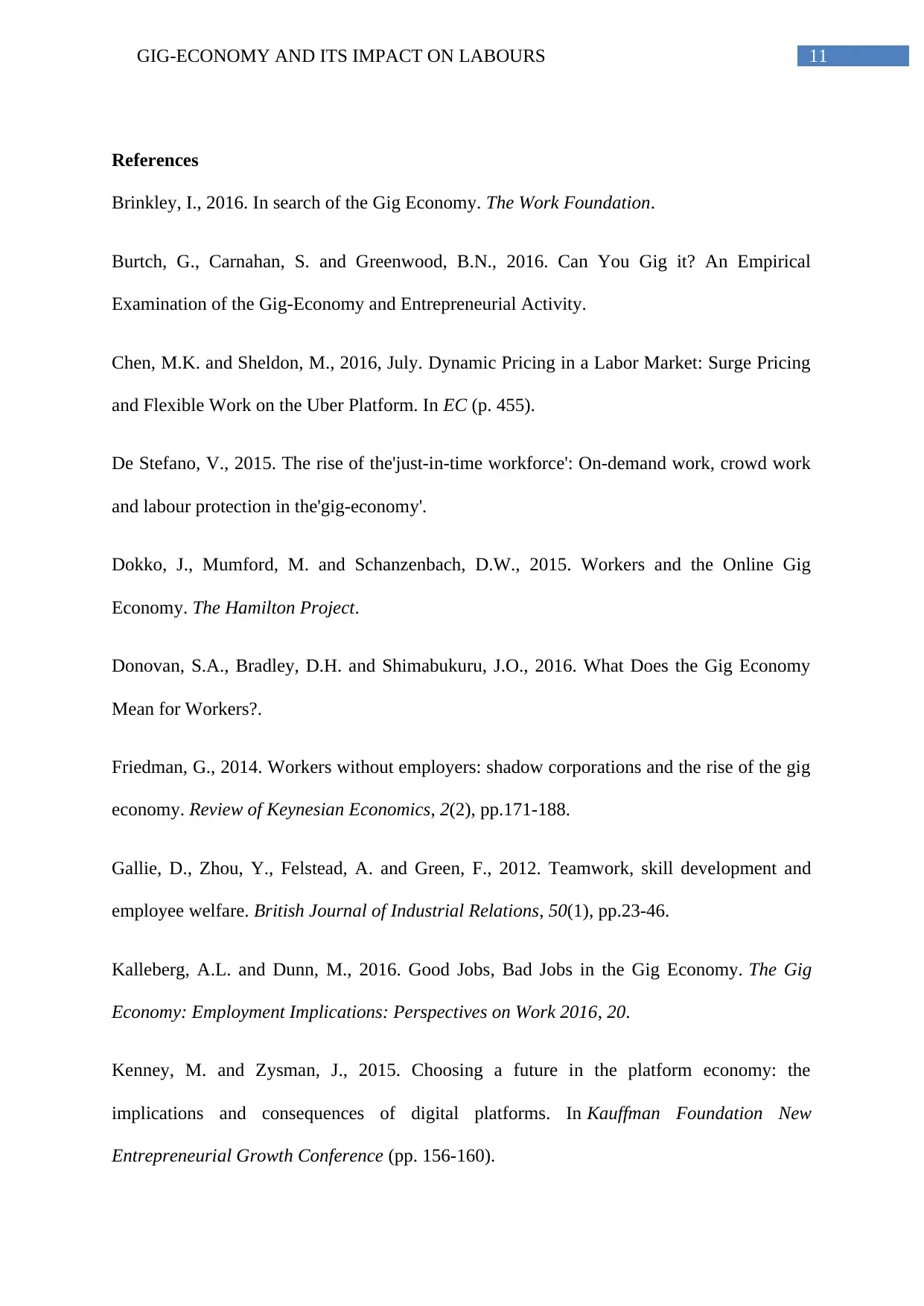
11GIG-ECONOMY AND ITS IMPACT ON LABOURS
References
Brinkley, I., 2016. In search of the Gig Economy. The Work Foundation.
Burtch, G., Carnahan, S. and Greenwood, B.N., 2016. Can You Gig it? An Empirical
Examination of the Gig-Economy and Entrepreneurial Activity.
Chen, M.K. and Sheldon, M., 2016, July. Dynamic Pricing in a Labor Market: Surge Pricing
and Flexible Work on the Uber Platform. In EC (p. 455).
De Stefano, V., 2015. The rise of the'just-in-time workforce': On-demand work, crowd work
and labour protection in the'gig-economy'.
Dokko, J., Mumford, M. and Schanzenbach, D.W., 2015. Workers and the Online Gig
Economy. The Hamilton Project.
Donovan, S.A., Bradley, D.H. and Shimabukuru, J.O., 2016. What Does the Gig Economy
Mean for Workers?.
Friedman, G., 2014. Workers without employers: shadow corporations and the rise of the gig
economy. Review of Keynesian Economics, 2(2), pp.171-188.
Gallie, D., Zhou, Y., Felstead, A. and Green, F., 2012. Teamwork, skill development and
employee welfare. British Journal of Industrial Relations, 50(1), pp.23-46.
Kalleberg, A.L. and Dunn, M., 2016. Good Jobs, Bad Jobs in the Gig Economy. The Gig
Economy: Employment Implications: Perspectives on Work 2016, 20.
Kenney, M. and Zysman, J., 2015. Choosing a future in the platform economy: the
implications and consequences of digital platforms. In Kauffman Foundation New
Entrepreneurial Growth Conference (pp. 156-160).
References
Brinkley, I., 2016. In search of the Gig Economy. The Work Foundation.
Burtch, G., Carnahan, S. and Greenwood, B.N., 2016. Can You Gig it? An Empirical
Examination of the Gig-Economy and Entrepreneurial Activity.
Chen, M.K. and Sheldon, M., 2016, July. Dynamic Pricing in a Labor Market: Surge Pricing
and Flexible Work on the Uber Platform. In EC (p. 455).
De Stefano, V., 2015. The rise of the'just-in-time workforce': On-demand work, crowd work
and labour protection in the'gig-economy'.
Dokko, J., Mumford, M. and Schanzenbach, D.W., 2015. Workers and the Online Gig
Economy. The Hamilton Project.
Donovan, S.A., Bradley, D.H. and Shimabukuru, J.O., 2016. What Does the Gig Economy
Mean for Workers?.
Friedman, G., 2014. Workers without employers: shadow corporations and the rise of the gig
economy. Review of Keynesian Economics, 2(2), pp.171-188.
Gallie, D., Zhou, Y., Felstead, A. and Green, F., 2012. Teamwork, skill development and
employee welfare. British Journal of Industrial Relations, 50(1), pp.23-46.
Kalleberg, A.L. and Dunn, M., 2016. Good Jobs, Bad Jobs in the Gig Economy. The Gig
Economy: Employment Implications: Perspectives on Work 2016, 20.
Kenney, M. and Zysman, J., 2015. Choosing a future in the platform economy: the
implications and consequences of digital platforms. In Kauffman Foundation New
Entrepreneurial Growth Conference (pp. 156-160).
⊘ This is a preview!⊘
Do you want full access?
Subscribe today to unlock all pages.

Trusted by 1+ million students worldwide
1 out of 15
Related Documents
Your All-in-One AI-Powered Toolkit for Academic Success.
+13062052269
info@desklib.com
Available 24*7 on WhatsApp / Email
![[object Object]](/_next/static/media/star-bottom.7253800d.svg)
Unlock your academic potential
Copyright © 2020–2025 A2Z Services. All Rights Reserved. Developed and managed by ZUCOL.





